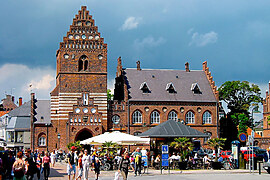Kevin Lynch’s theory is based on the measurement of Performance Characteristics of the spatial form of the city. The linkage between form and purpose which exist because of certain species characterizes the performance of cities and tells the difference of performance from one city to another.
Cities are compared to a Learning Ecology. The durability of a city, the resistance of the city to wear and tear. The connection between durability and form can be demonstrated through knowing the performance dimension.

Characteristics of performance dimension | Kevin Lynch
Characteristics should primarily refer to the spatial form of the city. The characteristics vary with different cultures. Characteristics should be independent of each other and examined through detailed analysis and should not influence another unless interdependence can be firmly established.
Concept of ecology
Each organism is in some relationship with another of its own kind as well as other species and the inorganic setting. An ecosystem is the closest metaphor that can be applied to a settlement. The organisms and elements are unthinking and are unable to modify the system in a fundamental way. The energy is lost and becomes unavailable. The system of learning Ecology is an appropriate concept. It constantly modifies itself and changes the rules of the game. It constantly restructures itself and switches the path of the energy flow.
The complex and dynamic interaction between the inorganic and organic components helps define the settlement form or ecology at all times.
Inorganic – System has • Diversity • Context • History • Feedback • Dynamic stability • Cyclic procession
Organic – Human factor adds • Values • Culture • Consciousness • Progressive and Regressive Change • Invention • The ability to learn • Connection of inner experience and outer action.
The statement of value should be integrated with the statement of objectivity.
The five Dimensions are 1. Vitality 2. Sense 3. Fit 4. Access 5. Control
And the two Meta Criteria are 1. Efficiency 2. Justice
1. Vitality | Kevin Lynch
There are three principal features conducive for good health:
- Sustenance 2. Safety 3. Consonance
SUSTENANCE – There should be an adequate supply of food, energy, water, air and disposal of waste for sustaining life. Sustenance is affected by: – Physical systems of supply and disposal – The location of the settlement – Effect of buildings and landscape on natural systems. – Soil conservation – The spatial device used to achieve this: crop lands, greenhouses soil conservation, managed forests, etc.
SAFETY: – Good settlement, hazards, poison and diseases are absent or controlled and the fear of encountering them is low. – Vandalism and crime are controlled – Pollution, contamination, disease are controlled. Treatment and defense to natural hazards are done. ( earthquake, fire, flood, etc.)
CONSONANCE: – The spatial environment should be in consonance with the biological structure. – Human factors should be included. – The present and the future stability of the ecological community should be taken care of.
2. Sense
Sense is the clarity with which the settlement forms can be perceived and identified. Sense depends not only on the spatial form but also on the culture, character, status, experience, and current purpose of the observer. Activities and celebrations associated with a location will change the sense of recognition associated with that setting.
The characteristics of sense:
- Identity 2. Structure 3. Congruence 4. Transparency 5. Legibility 6. Significance
IDENTITY: The ability of a person to recognize or recall the place. Place identity is linked with personal identity. Events have a sense of identity.
STRUCTURE: Composition of different elements in a space. Structure at a small scale helps how the elements work whereas at a large scale gives a sense of direction and orientation.
CONGRUENCE: Formal match between the environmental structure to non-spatial structure. Diagramming the parts, links of a place and then comparing with function, economy, society, natural process of the place.
TRANSPARENCY: The degree to which one can directly perceive the operation of various technical functions activities, social and natural processes that occur within the settlement.
LEGIBILITY: The degree to which the inhabitants of the settlement are able to communicate accurately via its features. A place can be analyzed for content, accuracy, and intensity by a familiar observer and interviews and photographs. Semiotics is one way of representing settlement patterns.
SIGNIFICANCE: Importance of the place
3. Fit | Kevin Lynch
Fit refers to how the spatial and temporal patterns of a settlement match the customary behavior of the inhabitants. A Place is modified to fit ways of behavior and behaviors are changed to suit a place. The program should be based on general, predictable behavior such as movement and social interaction. The program should have a set of quantities and the desired behavior and spatial quality associated with it. Fit is not a rigid link between action and place… the design should have overlapping of territories and permeability should be the key to the transition of spaces.
The features of Fit are:
- Adaptability 2. Manipulability 3. Reversibility 4. Excess Capacity 5. Improving Accessibility 6. Separation of parts 7. Modular and Standardization 8. Reduction of recycling cost
ADAPTABILITY: Measure of present and future use with minimum cost. A well-adapted place is which function and form are well fitted to each other. The relationship between adaptability and prediction is circulatory.
MANIPULABILITY: The extent to which the setting can be presently changed to in use and form in an easy incremental fashion to respond to future needs.
REVERSIBILITY: The understanding of the future dead ends and retracing the steps to the earlier or original state.
EXCESS CAPACITY: Providing good capacity so that future use can be accommodated easily. The settlement growth can be predetermined by the patterns and designed accordingly.
IMPROVING ACCESSIBILITY: Excess capacity and flexibility allow improvement in access for future use. Disaster management and deployment of information and resources are the keys to the survival of cities.
SEGREGATION OF PARTS: Reduction of interference between parts, change in one will not affect the other.
MODULAR AND STANDARDISATION: Modular structures that are apt for diverse functions. They are flexible and adaptable.
REDUCTION OF RECYCLING COST: Adaptability reduces the recycling cost as it intends to be used for a long period of time in spite of incremental changes. Reused and hence optimizes the cost and time.
4. Access
It is the ability to access goods, services, and places with minimum time and effort.
Classification of access:
- Access to people( relatives) 2. Access to human activities (work, recreation, religious places, etc.) 3. Access to material resources ( food, water, etc.) 4. Access to environment, shelter, open spaces 5. Access to information ( Interaction with all age groups, urban space with legibility)
The Characteristics of Access are:
- Diversity 2. Equality 3. Control
DIVERSITY: Refers to accessibility to diverse goods, services, people enabling the individual to choose.
EQUALITY: The access given to different groups of the population.
CONTROL: Access can be restricted for different user groups( like the pedestrians and vehicular)
Method of measuring Access:
- Time – Distance Maps • Linkage Diagram • Maps potential • Plots of substandard access • Mental maps of reachable territory
5. Control | Kevin Lynch
Control refers to the territorial occupation of a space and time for discharging day-to-day activities. Spatial control leads to strong psychological repercussions (war, Socioeconomic dominance) Different Spatial Rights are:
- Right of Presence – Right to be in a place and exclude others
- Right of use and action – Right of behaving freely in a place
- Right of Appropriation – Resource or a place is used and acquired in benefits and prevents others from using the facilities.
- Right of Modification – Right to modify the place without being a nuisance to others.
- Right of Disposition – the ability to transfer or give away the ownership over a place according to the need.
Aspects under control are:
- Congruence 2. Responsibility 3. Certainty
CONGRUENCE: Extent to which the inhabitants control the space in proportion with the degree of their permanent stake over it. Congruence allows security, satisfaction, and freedom.
RESPONSIBILITY: The people controlling the place should have the power, information, and motive to do it well.
CERTAINTY: People understand the control system, predict the scope, and feel secure with it.
6. Efficiency
Efficiency is essentially a Meta criterion and relates to the achievement in some performance to a loss in some others. It is a measure of the cost and benefits of any group distributed over values. Efficiency can be compared by seeing which achieves a better level in a particular dimension given a fixed value (cost).
7. Justice | Kevin Lynch
Justice is benefits and costs distributed between persons. This varies according to cultural and social hierarchies. Buying power – the money which is a combination of individual ability to the productive effort is Justice.
“It is vital, sensible, well fitted, accessible, well controlled and all of these are achieved with justice and internal efficiency………. It is continuous, well connected open place conducive to development”.
-Kevin Lynch, good city form


















